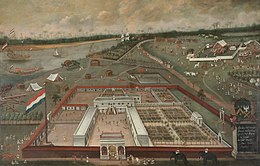
Back صوبة البنغال Arabic বংগ চুবাহ Assamese সুবাহ বাংলা Bengali/Bangla Bengal Subah Catalan Bengálská súba Czech Σουβάς της Βεγγάλης Greek Bengala Subaho Esperanto Subá de Bengala Spanish صوبه بنگال Persian Bengalin Subah Finnish
| Bengal Province Bengal Subāh | |||||||||||||||
|---|---|---|---|---|---|---|---|---|---|---|---|---|---|---|---|
| Province of Mughal Empire | |||||||||||||||
| 1576–1803 | |||||||||||||||
|
Flags
| |||||||||||||||
 Map of the Bengal Subah in 1776 | |||||||||||||||
| Capital |
| ||||||||||||||
| • Type |
| ||||||||||||||
| Historical era | Early modern period | ||||||||||||||
| 1576 | |||||||||||||||
| 1571–1611 | |||||||||||||||
• Establishment of Jahangirnagar | 1608 | ||||||||||||||
• de facto independence from Mughal Empire | 1717 | ||||||||||||||
| 1741–1751 | |||||||||||||||
| 1757 | |||||||||||||||
| 1764 | |||||||||||||||
• Grant of revenue to Company | 1765 | ||||||||||||||
• Grant of judiciary to Company | 1793 | ||||||||||||||
• Disestablished | 1803 | ||||||||||||||
| |||||||||||||||
| Today part of | |||||||||||||||
| History of Bangladesh |
|---|
 |
|
|
| History of India |
|---|
 |
| Timeline |

The Bengal Subah, also referred to as Mughal Bengal, was the largest subdivision of the Mughal Empire encompassing much of the Bengal region, which includes modern-day Bangladesh, the Indian state of West Bengal, and some parts of the present-day Indian states of Bihar, Jharkhand and Odisha between the 16th and 18th centuries. The state was established following the dissolution of the Bengal Sultanate, a major trading nation in the world, when the region was absorbed into the Mughal Empire. Bengal was the wealthiest region in the Indian subcontinent.
Bengal Subah has been variously described the "Paradise of Nations"[6] and the "Golden Age of Bengal".[7] It alone accounted for 40% of Dutch imports from Asia.[8] The eastern part of Bengal was globally prominent in industries such as textile manufacturing and shipbuilding,[9] and it was a major exporter of silk and cotton textiles, steel, saltpeter, and agricultural and industrial produce in the world.[10] The region was also the basis of the Anglo-Bengal War.[11]
By the 18th century, Bengal emerged as a semi-independent state, under the rule of the Nawabs of Bengal, who acted on Mughal sovereignty. It started to undergo proto-industrialization, making significant contributions to the first Industrial Revolution,[12][13][14][15] especially industrial textile manufacturing. In 1757 and 1764, the Company defeated the Nawab of Bengal at the Battle of Plassey and the Battle of Buxar, and Bengal came under British influence. It was deindustrialized[12][13][14][10] after being conquered by the British East India Company. In 1765, Emperor Shah Alam II granted revenue rights over Bengal to the Company and the judicial rights in 1793. In 1803, the Emperor ceased to be the suzerain of the Company and the "Province of Bengal, Behar and Orissa" of the Mughal Empire was thus formally annexed into the Presidency of Fort William of the East India Company.[16] In 1813, the East India Company Act 1813 transferred sovereignty of the Company's territories to the Crown.
- ^ Akhtaruzzaman, Muhammad (2012). "Tandah". In Sirajul Islam; Miah, Sajahan; Khanam, Mahfuza; Ahmed, Sabbir (eds.). Banglapedia: the National Encyclopedia of Bangladesh (Online ed.). Dhaka, Bangladesh: Banglapedia Trust, Asiatic Society of Bangladesh. ISBN 984-32-0576-6. OCLC 52727562. OL 30677644M. Retrieved 14 May 2024.
- ^ "Rajmahal – India". Encyclopædia Britannica. Archived from the original on 12 October 2018. Retrieved 5 April 2018.
- ^ "Dhaka – national capital, Bangladesh". Encyclopædia Britannica. Archived from the original on 10 October 2017. Retrieved 5 April 2018.
- ^ Rizvi, Saiyid Athar Abbas (1986). A Socio-intellectual History of the Isnā 'Asharī Shī'īs in India: 16th to 19th century A.D. Vol. 2. Munshiram Manoharlal Publishers. pp. 45–47.
- ^ Rieck, Andreas (15 January 2016). The Shias of Pakistan: An Assertive and Beleaguered Minority. Oxford University Press. p. 3. ISBN 978-0-19-061320-4.
- ^ Steel, Tim (19 December 2014). "The paradise of nations". Op-ed. Dhaka Tribune. Archived from the original on 17 May 2019. Retrieved 17 May 2019.
- ^ Islam, Sirajul (1992). History of Bangladesh, 1704-1971: Economic history. Asiatic Society of Bangladesh. ISBN 978-984-512-337-2.
- ^ Cite error: The named reference
Prakashwas invoked but never defined (see the help page). - ^ Indrajit Ray (2011). Bengal Industries and the British Industrial Revolution (1757-1857). Routledge. pp. 57, 90, 174. ISBN 978-1-136-82552-1. Archived from the original on 16 January 2023. Retrieved 20 January 2019.
- ^ a b Cite error: The named reference
starwas invoked but never defined (see the help page). - ^ Vaughn, James M. (March 2018). "John Company Armed: The English East India Company, the Anglo-Mughal War and Absolutist Imperialism, c . 1675–1690". Britain and the World. 11 (1): 101–137. doi:10.3366/brw.2017.0283.
- ^ a b Junie T. Tong (2016). Finance and Society in 21st Century China: Chinese Culture Versus Western Markets. CRC Press. p. 151. ISBN 978-1-317-13522-7.
- ^ a b John L. Esposito, ed. (2004). The Islamic World: Past and Present. Vol. 1. Oxford University Press. p. 174. ISBN 978-0-19-516520-3. Archived from the original on 16 January 2023. Retrieved 20 January 2019.
- ^ a b Indrajit Ray (2011). Bengal Industries and the British Industrial Revolution (1757-1857). Routledge. pp. 7–10. ISBN 978-1-136-82552-1. Archived from the original on 16 January 2023. Retrieved 20 January 2019.
- ^ Cite error: The named reference
senguptawas invoked but never defined (see the help page). - ^ The Bengalis. p. 143.

